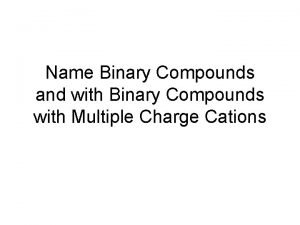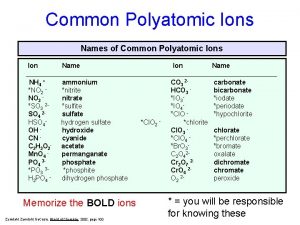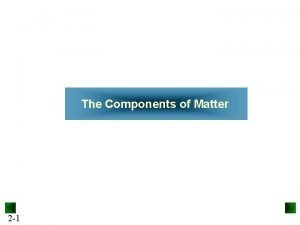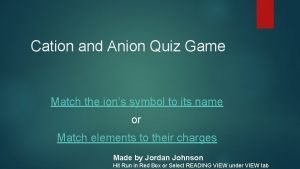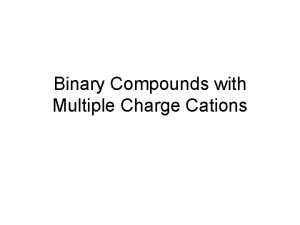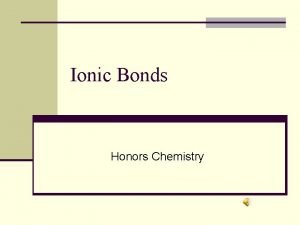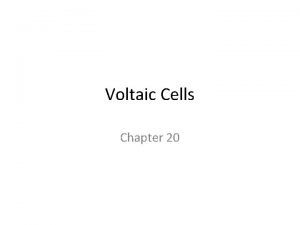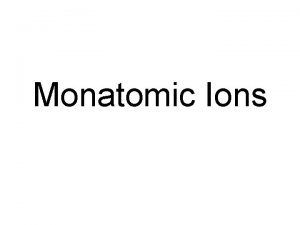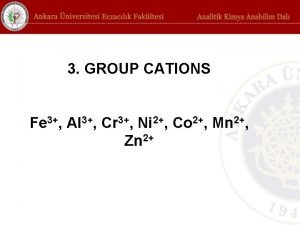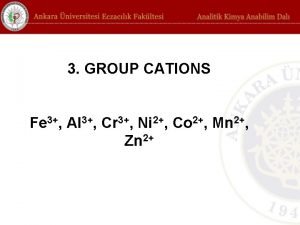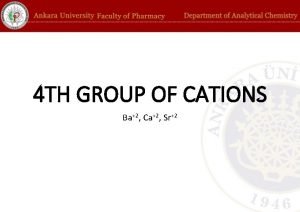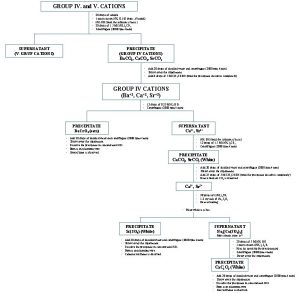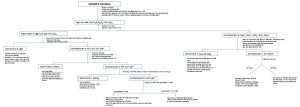GROUP V CATIONS Mg 2 Na K NH








- Slides: 8

GROUP V CATIONS (Mg 2+, Na+, K+, NH 4+) Ø There is not a common precipitating agent for the 5 th analytical group of cations. Ø Sodium and potassium are alkali metals. Ø NH 4+ is also in the group V because the compounds containing NH 4+ have similar properties with those with alkali metals. Ø Magnesium is an alkaline earth metal. But does not precipitate with the common precipitating agent of group IV. So it is left to the group V. Ø The salts of colourless anions and group V cations are colourless and have ionic bonds. So most of them are soluble in water. Ø That is why group V cations don’t have a common precipitating agent.

Mg 2+ions assay Ø All Mg compounds are colourless. Ø OH- precipitates of Mg adsorbs organic dyes. q. With Diphenylcarbazide reagent : § 20 drops of Mg 2+ sample is put in a test tube, 3 drops of Na. OH is added. § The occurring white precipitate is magnesium hydroxide (Mg(OH)2). § Add 3 drops of diphenylcarbazide reagent to the test tube. § Diphenylcarbazide dyes the precipitate of Mg(OH)2 to a red-purple color. § Because Mg(OH)2 adsorbs the organic dye diphenylcarbazide.

Na+ ions assay Ø Vapours of sodium salts give yellow colour in the flame test. Ø This yellow colour is filtrated by cobalt glass. Ø Vapours of NH 4 salts also give yellow colour in the flame test for a short time. Ø So if there is NH 4 in the sample, it must be removed. q. Flame test: § 10 drops of Na+ sample is taken, 10 drops of distilled water and 10 drops of concentrated HCI are added. § The cleaned platinum wire is immersed in the Na+ solution and trapped in the oxidant portion of the flame. § The presence of Na+ ions is observed with yellow color in the flame.

K+ ions assay Ø Vapours of potassium salts give violet colour in the flame test. Ø This violet colour is not filtrated by cobalt glass. Ø If you have a mixture of K+ and Na+ salts, the violet colour of K+ is masked by the yellow colour of Na+. Ø In this case, a cobalt glass must be use to prove the existance of K+. q Flame test: § 10 drops of K+ sample is taken, 10 drops of distilled water and 10 drops of concentrated HCI are added. § The cleaned platinum wire is immersed in the K+ solution and trapped in the oxidant portion of the flame. § The presence of K+ ions is observed with violet color in the flame.

NH 4+ ions assay Ø NH 4+ is a colourless cation and gives colourless salts with colurless anions. NH 4+ is only present in acidic medium. Ø In alkali medium, the followig reaction occurs. NH 4+ + OH- NH 3 + H 2 O Ø Ionic radius of NH 4+ is very close to K+. Hence NH 4+ gives most of the reactions that is given by K+. Ø Vapours of NH 4 salts also give yellow colour in the flame test for a short time. Can be mistaken for sodium. Ø So if there is NH 4 in the sample, it must be removed.

q With Na. OH solution : § 20 drops of NH 4+ sample is put in a test tube, 10 drops of distilled water is added. § The solution is basified with 10 drops of Na. OH. § When the basified solution is heated in a water bath, the mouth of tube is kept with red litmus paper moistened with distilled water. § Otherwise, the presence of NH 4+ ion can not be monitored since NH 3 gas is moving away from the medium. § Red litmus paper turns blue, this shows the presence of NH 4+ ion.

Analysis of Group 5 th Cations Ø If NH 4+ is present in the sample, the analysis of Na+ and K+ ions becomes more difficult. Because NH 4+ is yellow in the flame test like Na+. For this reason, it should first be checked whethere is NH 4+ in the sample. If NH 4+ is not present in the sample, Na+ and K+ are searched for, if any, NH 4+ is removed first. § 20 drops of NH 4+ sample is put in a test tube, 10 drops of distilled water is added. § The solution is basified with 10 drops of Na. OH. § When the basified solution is heated in a water bath, the mouth of tube is kept with red litmus paper moistened with distilled water. § Otherwise, the presence of NH 4+ ion can not be monitored since NH 3 gas is moving away from the medium. Red litmus paper turns blue, this shows the presence of NH 4+ ion.

Removing NH 4+ from sample solution: § 50 drops of sample are taken to a porcelain crucible and the sample solution is evaporated to dryness on wire gauze. § At the end of the dissolution, the suspension is continued by the addition of 10 drops of concentrated HCl. § The wire gauze is removed after a while, the crucible is taken to the triangle and the naked flame heating is done. § This process is continued until the output of white NH 4 Cl vapors is exhausted. § After the crucible is cooled, add 50 drops of distilled water onto the residue and completely dissolve. § The solution obtained is used for the analysis of Mg 2+, Na+ and K+ ions.

